Birch trees are one of my favorite trees. Not only are they beautiful, with their distinctive bark and slender trunks, but they are also beneficial.
Birch can be used medicinally, can provide survival food, and can be used to make furniture and crafts. You would think that would be enough for everyone to know about it.
But there’s more. Birch also plays host to a fungus that can boost your immune system. Keep reading to learn more about this survival tree.
Distribution
Birch is such a valuable plant to know because you can find it just about everywhere.
Related: The Most Common Edible Trees Growing In Your State
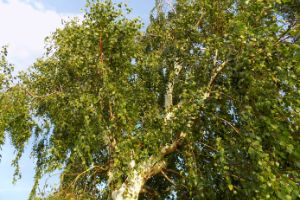 Birch trees are native throughout the Northern Hemisphere, so you can find them growing just about anywhere you find yourself. They are in Europe, Asia, and North America.
Birch trees are native throughout the Northern Hemisphere, so you can find them growing just about anywhere you find yourself. They are in Europe, Asia, and North America.
In North America they can be seen as far north as Alaska, and there are even species that are native to Arizona.
There are more than 40 different species, and each has unique growth requirements. So keep your eye out to learn which species are common in your area.
Despite the differences, the species do have some commonalities, so let’s learn how to identify them.
Identification
With many species of birch out there, it can be overwhelming to think of learning to identify them all.
I recommend focusing on the species that are common in your local area. However, there are some similarities among the different species.
⇒ Learn How To Tell Apart Edible Plants And Their Poisonous Lookalikes
The easiest way to identify birch is by looking at the bark and leaves.
While birch can appear similar to either beech or aspens, it becomes easy to distinguish them once you know what you are looking at.
Bark
When looking at birch trees, the bark always stands out.
While the color of the bark changes depending on the species, they all feature distinctive lenticels– dark horizontal lines. The bark also often separates easily into thin papery sheets.
Leaves
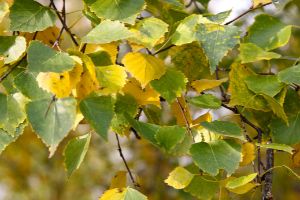 Birch trees usually have triangular or spear-shaped leaves with serrated edges. The base is rounded, and the tips are pointed.
Birch trees usually have triangular or spear-shaped leaves with serrated edges. The base is rounded, and the tips are pointed.
While they are glossy green in spring and summer, birch leaves change to magnificent reds, yellows, and oranges in fall.
Uses
Once you have correctly identified your birch trees, it seems like their uses are endless.
The tree can be used medicinally, tapped for sap, eaten, and used for crafts. Let’s look at these more closely.
Medicinally
Birch leaves, twigs, and bark can all be used medicinally. Leaves and twigs are known to be anti-inflammatory and relieve pain.
⇒ Similar to Morphine: The Best Natural Painkiller That Grows In Your Backyard
It is best to harvest in the spring when the sap is flowing. This will give you the greatest concentration of beneficial chemicals.
The best way to use twigs is to tincture them in alcohol. That will help extract the terpenes that give birch its distinctive wintergreen scent and flavor.
Leaves can be steamed and inhaled for respiratory problems. You can also brew them into a tea to treat various times of inflammatory pain and kidney and urinary problems.
Spring buds can also be infused into oil and used topically for pain relief and to help with certain skin conditions.
Sap
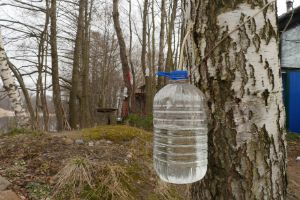 We all know you can tap maples for syrup, but did you know you can tap birch as well? Yup. It’s true.
We all know you can tap maples for syrup, but did you know you can tap birch as well? Yup. It’s true.
While birch sap isn’t as sweet as maple syrup, it does have a distinct wintergreen flavor that made it a popular additive in sarsaparilla. You tap birch trees in the spring, just like maples.
Birch sap can be consumed fresh, straight from the tree, fermented into wine, or cooked down into a syrup.
If you are thinking about making syrup, you should know it takes more birch sap than maple sap to achieve the same amount of syrup.
Bark
Native Americans traditionally used birch bark to make canoes, baskets, and other waterproof containers. But did you know that it is a survival food as well?
I won’t tell you that it tastes great, but it will keep you alive in a pinch. It’s the soft inner bark that is edible.
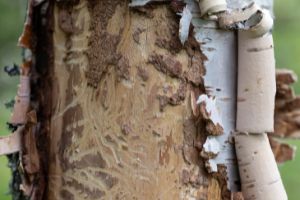
To reach the edible part, you will need first to peel off the outer bark.
This should be done lengthwise rather than horizontal to cause less damage to the tree.
Don’t dispose of the outer bark. You can use it to make a waterproof container.
Once you have removed the papery bark, you will find the soft inner bark that you can eat. Now you can grind it up into a paste or dry it out and use it as flour.
Wood
Birch trees produce attractive wood that carpenters use in construction. It is often used to make furniture and cabinetry. But it also has other more practical survival uses.
Birch makes excellent firewood. It will burn well even if you harvest it in the dead of winter. Frozen logs will burn, helped out a bit by the oils in the bark. You can shave down some logs to create firestarters as well.
Chaga Mushroom
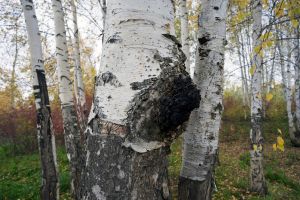 The Chaga mushroom is a parasitic fungus that can be found on birch trees. It looks a bit like black charcoal growing on the trunk. Don’t be put off by the appearance.
The Chaga mushroom is a parasitic fungus that can be found on birch trees. It looks a bit like black charcoal growing on the trunk. Don’t be put off by the appearance.
This mushroom has many medicinal qualities, including heart disease and aiding with diabetes.
However, It is primarily used to reduce inflammation and boost your immune system.
What If You Can’t Find a Birch Tree
While birch is one of my favorite survival trees out there, it is certainly not the only tree with many uses. You will find that maple trees are another example of useful trees to be able to identify in a survival situation.
We all know about maple sap and syrup, but did you know the leaves are edible as well? That’s right, they are.
Pick them when they are young and tender rather than older and tougher. You can eat raw or cooked, whichever you prefer. You can also eat the seeds and inner bark.
You will also find numerous medicinal uses for the leaves and bark from the maple tree.
In fact, the more you study the trees around you, the more uses you will find for trees in your backyard.

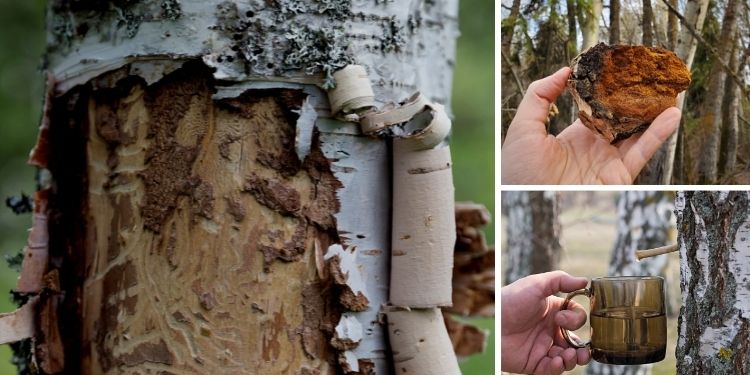




















Yeah beavers like the, too. So I killed them all
I meant to press the “dislike” button…
Really bad comment.on their part.
raven: and the tress where probably there because beaver carried the seeds. why are you so anti-Bible?
You kill the beavers or the tree ? Or both . Leave them alone bonehead.
Beavers are disgusting rodents. They will destroy the trees and flood the fields
Jon. Donno what his religion is, but it is against the Law of God to kill anything without good reason. One beaver is not going to wipe out a field. niio
KJK just post the addy. It comes thru. niio
Beavers slow the water down so that it can sub-irrigate the meadows along the creek. My grandfather put up the hay in those meadows to feed his cows in the winter. Then later, my dad removed the beavers for some reason. What was lush meadow is now dry pasture.
They flood fields damage ponds……it’s a mess
Yes, they’re fantastic at controlling floods, as well. the perfect fishing hole, great summing hole. Great place to have ducks and geese. When a bunch moved to an uncle’s farm, they did some damage, so he would lob a quarter stick of dynamite into the middle of their pond. By mid summer, they moved down stream and he kept the pond for wild rice and stuff till it silted up–something beaver would have prevented. niio
Birch bark is also an excellent fire starter even damp. With some care even in a rainstorm you can peel enough mostly dry to get a fire started.
In Eastern Europe tree fodder is common as hay uses too much crop growing land for critters. Even rabbits enjoy the browse.
Pretty good article, thanks
Watch out for birch diseases! Here in the Metro NYC Region and on Long Island, we have lost most birch trees to disease. I was devastated when I had to take my trees down. Birch borers are the culprit! We have to replace them with River Birch which is not effected.
When I was up in Jersey we had em. Down here havent seen em. Between these and the pines on the property, I’m hoping I can I can avoid having to eat my neighbors. You think I like having to size up my neighbors? No. But my babies ain’t gonna starve.
emrick: you can raise rabbits like they did in the middle ages, inside a fence where they do their own thing till you need some. You would have to dig down about 3 feet to bury the bottom of the fence. This is getting common in Arizona. If neighbors don’t mind, bantam chickens tend to be prolific at making more chickens, and generally feed themselves. Eggs, now good at them, 150 or so a year, but when a hen hatches, take the chicks from her and raise them to fledgling stage in the house. In a week or so, the hen will go back to laying another clutch. Muscovy ducks are the same. A plus, they will roost. niio
That is a very interesting article. I don’t have anything to add to
the topic as Michael would want.
It’s sad that we read the psychotic comments from the ever
present “Raven Piece of Shit” or “Piece of Shit Raven”.
Which ever you prefer.
Every forum has trolls, ignore them, they feed off your emotions. Read about narcissists.
I can add one thing. The article forgot the medicinal “Birch Polypore.” I hope I spelled it right. Close enough for a keyword search anyways.
There you go. I’ve been collecting for 8 years. You find dead birch you will come across these little gems. Cut thin immediately, or they will become rock hard. Place in brown paper bag and shake once in awhile. Will dry in about a month
Birch Polypore is much more common than Chaga. I have not come across any of that in 8 years.
One important note; take no more than 2/3 of the Chaga. Allow it to re-grow. It will take years and years…however.
Another great tree is Moringa, but you must live down south to grow them.
Jeff, I grow Moringa in too sunny< and very hot Phoenix. Currently, my trees are loaded with bean pods.
Lisa: morninga beans? Wow, lucky you, but then, you’re warmer than my Zone 9. I’m happy if the trees come back in summer after freezes burn them down. A ton of blooms, but no beans, erk 🙂 niio
Great read! I am blessed to live in upper New York where Birch is plentiful. I learned quite a bit from this read and appreciate you sharing this with us.
Wow! Great information. I never realized how much nature really provides. Thanks!!
I have several of your books. I would like to have them all, but I do not have the money to order them. When ever I have had enough to order a book, I have done so. and will do so in the future. I am an Herbalist. To me, these books are as valuable as gold.
ain’t no such critter in my neck of the woods like birch. Not even white and that stuff can take the heat, but needs a lot of water. But! Maple we do have. Sugar maple (bigtooth) and a few other drought tolerant varieties. niio
Would have been nice to hear which of the many species would be best to grow.
Matt: All of them but I favor black birch. to confuse the issue even more… 🙂 niio
Birch – Tree Medicine
I have lived in South Florida, the mountains outside Denver, Colorado and the Texas Panhandle, among other places. Have never seen a birch tree in any of those places. Had some beautiful birch trees in Western NY, along with sugar maples, as well as having both species in Northern NJ. I might see if I can buy a birch tree online and grow it here. I have a magnolia that is surviving – so far – and two maples. Might as well try for a third non-native.
You can dunk birch bark into a bucket of water and still use it to start a fire with flint & steel.
sabel: there are birch native to Florida. niio
Birch Trees In Florida And Other Thriving Trees In The State
That explains why I never saw any…I was mostly in South Florida and my husband was from an area east of Tampa so still fairly far south, I guess. Then, again, I didn’t spend a lot of time looking for birches while I lived there. Was more interested in the tropical trees that were fast growing.
I am always amazed how similar looking aspens and birches are. Both are beautiful trees. The cool thing about aspens is the fact that a grove of aspens is all one single organism, interconnected through their root system. That is why they all turn color at the same time in the autumn.
Birch is a wonderful tree to plant in areas where you might have poor drainage. It sucks up a lot of water and can help prevent dampness in a basement or pooling on the ground after a storm.
CC, donno know about that. I have yet to see it here, but up in towns lost a lot of houses planted on the Salt River- and Gila flood plains. I like birch trees and an a semi-addict to birch and root beer 🙂 niio
Thank you for a useful article, I found you through Google